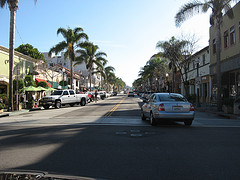![]() photo credit: Ken Lund
photo credit: Ken Lund
Compared to suburban greenfield sites, developing infill brownfield property is complicated and costly. We must level the playing field by implementing policies that make infill properties desirable to investors. Many cities and states are following Maryland’s example. In 1997, the state adopted a Smart Growth Areas Act that coordinates economic development with planning. The Act specifies that Maryland will only spend infrastructure and economic development dollars in priority areas that are already served by infrastructure or are planning to build infrastructure – this policy has allowed Maryland to dramatically reinvest in repair, maintenance, and upgrade of existing infrastructure in its urban core.
The region is the fundamental economic unit of the world. For cities to prosper, the region must adopt smart growth policies and actions that favor infill growth over sprawl. Competitive sales wars between cities hurt the region. Businesses moving out of a city to a sprawling greenfield site results in declining revenues and services for the city and loss of land for agriculture and open space in the areas receiving the growth.1 This is a net loss to the region’s economy, environment, and quality of life. Reinvesting in the aging and struggling areas builds the revenue base of the city and benefits the urban core and the suburbs.
Smart growth and green development decisions make efficient use of taxpayers’ investments in infrastructure improvements and services such as police and fire. Ventura, California, is currently implementing a smart growth-based General Plan that focuses on protecting natural resources while promoting high-quality, low impact urban infill development. Smart and compact growth insures us against any limits that high energy costs may impose on our ability to drive everywhere.“In the face of such global threats and opportunities, local communities must fundamentally reshape their approach to economic development away from targeting aggregate growth as an end in itself. Instead, our focus will need to be on fostering a healthy economy that is integrated with our concern for the environment and social equity, the three pillars of sustainability,” says Ventura City Manager Rick Cole. “Easier said than done, of course. It is not enough to simply slap a ‘green’ label on recycled conventional strategies. We need to not only rethink, but redo our approach. In Ventura, for example, we pay less attention to sales tax revenue and more to the retention and creation of high-value, high-wage jobs that generate the wealth that is the underlying source of retail sales. In a time of transition, our need is not for a perfect academic model. Instead, it is time to experiment with fundamentally changed approaches. The communities that successfully do so will be the real models for the 21st century.”
One obstacle to smart growth is the current zoning codes. Conventional zoning codes separate the daily needs of shopping, housing, and work into disjointed zones accessible only by automobiles. A large number of cities are replacing their conventional zoning codes with form-based codes. Form-based coding is an integrated place-based approach that focuses on the careful design of the public realm: the street, open spaces, and the public face of private buildings. Land uses are not ignored but regulated by broad parameters that better respond to market economics and allow for a mix of uses serving daily needs within easy walking distances. Predictable outcomes and a streamlined process that reduces discretionary review are other business-friendly attributes of this coding method. Peter Katz, an urban theorist and Form-Based Code Institute2 president says, “Form-Based Codes are strongly linked to public participation programs and lead to more appropriately scaled projects that are more consistently linked with the needs of emerging economies

